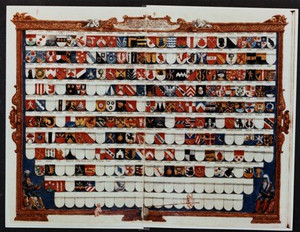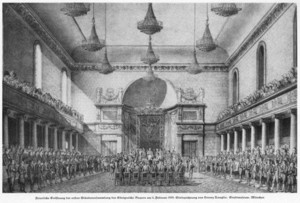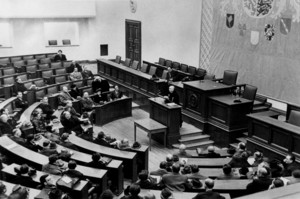History
The Bavarian State Parliament is one of Germany’s oldest parliaments. It is one of the most important contributors to the development of European parliamentarianism. Its origins stretch back to the beginning of the 14th century. The first steps towards its creation took place in lower Bavaria.
1311
"The Ottonian Handfast" of 15 June marked the beginning of Bavaria’s parliamentary history. Otto III, Duke of Lower Bavaria/Landshut, of the House of Wittelsbach, urgently required money. For this, the Lower Bavarian nobility approved a new tax; however, at the same time, it had its own rights (e.g. summary jurisdiction) confirmed. This document became the basis for the freedoms of the three "Landstände" (Estates) of nobility, clergy and cities. These Estates were also called "Landschaft"
(territorial assembly of estates).
1508
1669
1808
When Bavaria was near to entering state bankruptcy during the Napoleonic Wars, only a modern constitution with a parliament now seemed to guarantee the unity of the state and orderly finances. Hence on 1 May, King Max I Joseph issued a constitution that granted certain basic civil rights. The old "Landschaft" was dissolved. The planned national representation remained undone.
1818
King Max I Joseph now saw himself forced to issued a new constitution. Based on the English model, it stipulated an assembly of the estates with two chambers. The 1st chamber – that of the "Reichsräte" (Imperial Councils) – consisted of members by virtue of birth, wealth, office or royal appointment. The 2nd chamber consisted of – partly indirectly – elected parliamentarians from the nobility, the clergy, the bourgeoisie and the farming community.
1819
1849
The Bavarian Parliament officially received the name "Landtag". From 1819 to 1934, the seat of the State Parliament was the building at Prannerstraße 20 (near Promenadeplatz) in Munich.
1881
Secret election by secret ballot of the members of the State Parliament was introduced.
1907
For the first time, the complete Chamber of Deputies was directly elected. Only males of 25 years of age or older had the right to vote.
1918
The end of the First World War also brought the end of the constitutional monarchy. In the revolutionary night between 7 and 8 November, Bavaria was declared a republic. King Ludwig III fled. Kurt Eisner, the leader of the USPD (Independent Social Democratic Party of Germany), became the first Minister-President of the new republic (Free State).
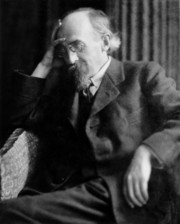
1919
On 12 January, the Bavarian people elected a State Parliament that was a pillar of popular sovereignty in the complete sense for the first time. Women now also had the right to vote. When unrest broke out in Munich following the murder of Kurt Eisner, the State Parliament and the government withdrew to Bamberg. There, a new Bavarian Constitution entered into force. It provided for only one chamber – the State Parliament.
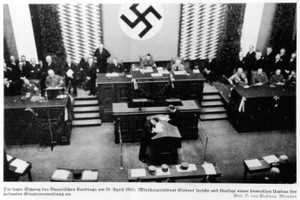
1933
On 28 and 29 April, the Bavarian State Parliament came together for the last time. The National Socialists had already assumed power in Berlin.
1934
An "imperial law" of 30 January abolished all state parliaments.
1946
After the Second World War, democratic parties were allowed again by the American military government. On 26 February, an "Advisory State Committee" met in the assembly hall of Munich University as a pre-parliament. At that time, Dr Wilhelm Hoegner had been installed as Minister-President by the military government. Then, on 30 June, a Constitutional State Assembly was elected for the first time in Bavaria’s history. It was made up of members of the CSU, SPD, FDP and KPD parties. With the creation of the Bavarian Senate, the Bavarian tradition of the two-chamber system was taken up again. On 1 December, the people approved the new constitution and elected a new State Parliament at the same time. Since the old State Parliament building on Prannerstraße had been completely destroyed, the newly elected Parliament initially met at Munich University, at the Brunnenhof Theatre of the Munich Residenz and in the Sophiensaal hall of the Regional Tax Office.
1949
In January, the Bavarian State Parliament and the Bavarian Senate moved into the renovated Maximilianeum. Since then, "Maximilianeum" and "Bavarian Parliament" have become synonyms.

